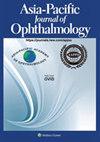Outcomes of Goniotomy With or Without Secondary Intraocular Lens Implantation in Pediatric Glaucoma Following Cataract Surgery: A Prospective Pilot Study
IF 3.7
3区 医学
Q1 OPHTHALMOLOGY
引用次数: 0
Abstract
Purpose:
To report the outcomes of a 120-degree goniotomy (GT) with or without secondary intraocular lens (IOL) implantation in glaucoma following cataract surgery (GFCS).
Design:
Prospective, observational study.
Methods:
Pediatric patients with GFCS who underwent standalone 120-degree GT or 120-degree GT combined with secondary IOL implantation (GT+IOL) from March 2022 to August 2022 at the Zhongshan Ophthalmic Center were recruited. Primary outcomes were intraocular pressure (IOP) and the number of ocular hypotensive medications. A secondary outcome was the surgical success rate. Success was defined as a postoperative IOP within the range of 5–21 mm Hg. Complete and qualified successes were defined, as the above, without and with ocular hypotensive medications, respectively.
Results:
Thirty-two eyes of 22 patients were included. The mean age at the time of GT was 68.5 ± 29.3 months. The mean follow-up duration was 12.2 ± 2.3 months (9–15 mo). Mean IOP decreased from 30.9 ± 4.8 mm Hg on 2 (interquartile range = 1) medications at baseline to 15.8 ± 3.6 mm Hg on 0 (interquartile range = 1.5) medication at the latest visit in all eyes. The overall complete and qualified success rates were 68.8% and 90.6%, respectively. There were no significant differences in IOP, number of medications, and complete and qualified success rates between the standalone GT and GT+IOL groups at the latest follow-up at 9 months postoperatively.
Conclusions:
To reduce the need for additional surgery, 120-degree GT was a safe and effective surgical treatment for GFCS in children, which could be combined with secondary IOL implantation in aphakic eyes with GFCS.
白内障手术后儿童青光眼的性腺切除术伴或不伴二次人工晶状体植入的结果:一项前瞻性的初步研究。
目的:报告白内障手术(GFCS)后青光眼120度角切开术(GT)伴或不伴二次人工晶状体(IOL)植入的疗效。设计:前瞻性、观察性研究。方法:招募2022年3月至2022年8月在中山眼科中心接受独立120度GT或120度GT联合二次IOL植入(GT+IOL)的儿童GFCS患者。主要结果是眼压(IOP)和眼部降压药物的数量。次要结果是手术成功率。成功定义为术后眼压在5-21范围内 毫米 汞。如上所述,完全和合格的成功分别定义为不使用和使用眼部降压药物。结果:22例患者32眼。GT时的平均年龄为68.5±29.3个月。平均随访时间为12.2±2.3个月(9-15个月)。平均眼压从30.9±4.8 mm下降 基线时2种药物(四分位间距=1)的汞柱为15.8±3.6 mm 所有眼睛在最近一次就诊时服用0(四分位数间距=1.5)药物的Hg。总体完成率和合格率分别为68.8%和90.6%。在术后9个月的最新随访中,独立的GT和GT+IOL组在IOP、药物数量以及完全和合格的成功率方面没有显著差异。结论:为了减少额外手术的需要,120度GT是一种安全有效的儿童GFCS手术治疗方法,可与GFCS无晶状体眼的二次人工晶状体植入相结合。
本文章由计算机程序翻译,如有差异,请以英文原文为准。
求助全文
约1分钟内获得全文
求助全文
来源期刊

Asia-Pacific Journal of Ophthalmology
OPHTHALMOLOGY-
CiteScore
8.10
自引率
18.20%
发文量
197
审稿时长
6 weeks
期刊介绍:
The Asia-Pacific Journal of Ophthalmology, a bimonthly, peer-reviewed online scientific publication, is an official publication of the Asia-Pacific Academy of Ophthalmology (APAO), a supranational organization which is committed to research, training, learning, publication and knowledge and skill transfers in ophthalmology and visual sciences. The Asia-Pacific Journal of Ophthalmology welcomes review articles on currently hot topics, original, previously unpublished manuscripts describing clinical investigations, clinical observations and clinically relevant laboratory investigations, as well as .perspectives containing personal viewpoints on topics with broad interests. Editorials are published by invitation only. Case reports are generally not considered. The Asia-Pacific Journal of Ophthalmology covers 16 subspecialties and is freely circulated among individual members of the APAO’s member societies, which amounts to a potential readership of over 50,000.
 求助内容:
求助内容: 应助结果提醒方式:
应助结果提醒方式:


